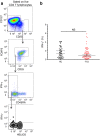IL-21 production by CD4+ effector T cells and frequency of circulating follicular helper T cells are increased in type 1 diabetes patients
- PMID: 25652388
- PMCID: PMC4351433
- DOI: 10.1007/s00125-015-3509-8
IL-21 production by CD4+ effector T cells and frequency of circulating follicular helper T cells are increased in type 1 diabetes patients
Abstract
Aims/hypothesis: Type 1 diabetes results from the autoimmune destruction of insulin-secreting pancreatic beta cells by T cells. Despite the established role of T cells in the pathogenesis of the disease, to date, with the exception of the identification of islet-specific T effector (Teff) cells, studies have mostly failed to identify reproducible alterations in the frequency or function of T cell subsets in peripheral blood from patients with type 1 diabetes.
Methods: We assessed the production of the proinflammatory cytokines IL-21, IFN-γ and IL-17 in peripheral blood mononuclear cells from 69 patients with type 1 diabetes and 61 healthy donors. In an additional cohort of 30 patients with type 1 diabetes and 32 healthy donors, we assessed the frequency of circulating T follicular helper (Tfh) cells in whole blood. IL-21 and IL-17 production was also measured in peripheral blood mononuclear cells (PBMCs) from a subset of 46 of the 62 donors immunophenotyped for Tfh.
Results: We found a 21.9% (95% CI 5.8, 40.2; p = 3.9 × 10(-3)) higher frequency of IL-21(+) CD45RA(-) memory CD4(+) Teffs in patients with type 1 diabetes (geometric mean 5.92% [95% CI 5.44, 6.44]) compared with healthy donors (geometric mean 4.88% [95% CI 4.33, 5.50]). Consistent with this finding, we found a 14.9% increase in circulating Tfh cells in the patients (95% CI 2.9, 26.9; p = 0.016).
Conclusions/interpretation: These results indicate that increased IL-21 production is likely to be an aetiological factor in the pathogenesis of type 1 diabetes that could be considered as a potential therapeutic target.
Figures



References
Publication types
MeSH terms
Substances
Grants and funding
LinkOut - more resources
Full Text Sources
Other Literature Sources
Medical
Research Materials

